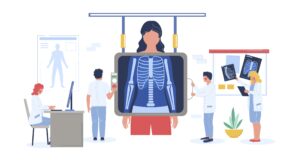The new normal of working from home suits many of us quite nicely. We have no traffic to battle, constant access to a kitchen for snacks, and tracksuit bottoms and slippers is entirely acceptable work attire for a Zoom meeting.
 But the luxury of a laptop on the sofa can also be taking its toll on our spine and posture muscles, forcing our backs into unnatural positions for longer periods – especially if we don’t have a designated home office . I met with Physiotherapist Zoe O’Neill who explained that ‘a healthy spine should naturally adopt a mild S-shape. Our bodies are designed to be moving and active, constantly using muscles to support the skeleton. When we slouch or sit for a long time, our muscles that support the spine get weaker so that they do not support our back or hips enough. This makes us more likely to develop injuries to our backs and hips. Our internal organs and gut also do not function well when we sit for long periods. ’
But the luxury of a laptop on the sofa can also be taking its toll on our spine and posture muscles, forcing our backs into unnatural positions for longer periods – especially if we don’t have a designated home office . I met with Physiotherapist Zoe O’Neill who explained that ‘a healthy spine should naturally adopt a mild S-shape. Our bodies are designed to be moving and active, constantly using muscles to support the skeleton. When we slouch or sit for a long time, our muscles that support the spine get weaker so that they do not support our back or hips enough. This makes us more likely to develop injuries to our backs and hips. Our internal organs and gut also do not function well when we sit for long periods. ’
Fortunately she has some simple and effective tips for our working day to keep our backs happy, healthy, flexible and pain free. Pleasingly, they all begin with S, like the shape of our healthy spine.
Sit properly
Making your working environment and desk space ergonomic and comfortable can transform the way your spine aligns and promote good posture. Zoe says, ‘Modern working life has changed the demands placed on our bodies dramatically compared to the days when the majority of work involved physical labour. We associate sitting with relaxing and there is certainly a place for this. However, we should not do computer work in the same posture in which we watch TV. If our muscles are not asked to work for most of the day, they will not respond properly when we do need them to work – a perfect recipe for injury. I would say correct sitting posture is not limited to a single position and in fact it is healthier for your body and mind to switch positions and readjust throughout the day’.
Sitting at a desk and upright chair that encourages a good posture will help a lot. Any chair should enable you to have your feet flat, with a space the size of your fist between the chair and the back of your knees. There are many posture-supporting chairs on the market, as well as unconventional alternatives such as gym balls and kneeling chairs. These may be a worthwhile investment if working at home is going to be a longer term prospect for you. You can even ditch the chair completely if you have a standing desk! A mixture of different types is perfect but whatever you do, do not work on your sofa.
Stand up a lot
When you are concentrating on work it is easy to sit still for longer than you mean to, so set a timer for every half an hour (at least) for some movement to get up off your chair. Zoe also suggests walking around while you are on the phone, go up and down the stairs to get a cup of tea, or squeeze in a few squats or press ups if you’re a really keen bean. There are many brilliant apps that offer workouts that you can fit into even the smallest five minute time slots that can be a lot more motivating to get moving, and don’t require a shower afterwards.
Stretch even more
Making stretching a part of our working day will stop muscles from shortening when we sit and type, such as our hip flexors. Make it a normal part of your movement break to stretch your arms up and around, or fit in a longer relaxing stretch at the end of your working day.
Strengthen muscles that support your back
 Your core muscles are a key part of correct posture, so exercises that strengthen your back, hips and tummy muscles will help them stay toned to support your back and prevent injury. Full-body planks, lunges, squats, or Pilates movements as part of an exercise program are all excellent for posture. Top tip from Zoe: ‘Doing squats with your arms above your head will give you more bang for your buck as your core muscles are used to stabilise your back as you move up and down’.
Your core muscles are a key part of correct posture, so exercises that strengthen your back, hips and tummy muscles will help them stay toned to support your back and prevent injury. Full-body planks, lunges, squats, or Pilates movements as part of an exercise program are all excellent for posture. Top tip from Zoe: ‘Doing squats with your arms above your head will give you more bang for your buck as your core muscles are used to stabilise your back as you move up and down’.
Slurp
When we are dehydrated, the spinal disks that lubricate movement in our backs literally deflate their water cushion, so the bony parts of the spine end up taking on the pressure of a back movement. This causes pain through the sensitive nerves all around your spinal column. On top of that, dehydrated and weak muscles in the back can become stiff and sore, and go into spasm trying to support your back. Zoe always advises her clients to drink enough to have ‘pale pee’, a good indicator of hydration.
Being mindful of your spine while you work will not only get you a better back but also avoid seemingly unrelated things such as constipation, headaches, insomnia and injury with normal daily life, so it will totally pay off in the long run. You can consider that next time you set off on your three second commute.
